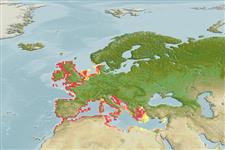>
Blenniiformes (Blennies) >
Blenniidae (Combtooth blennies) > Salariinae
Etymology: Parablennius: Greek, para = the side of + Greek, blennios = mucus (Ref. 45335).
More on author: Linnaeus.
Environment: milieu / climate zone / depth range / distribution range
Ekologi
laut dasar (demersal); nir-ruaya; kisaran kedalaman 3 - 32 m (Ref. 5981). Subtropical; 59°N - 31°N, 11°W - 35°E
Northeast Atlantic: Atlantic coast from Ireland to Morocco; also in the Mediterranean Sea and the Sea of Marmora. This species is present only in mainland Portugal (Ref. 13612). Although older papers reported this species from the Azores and Madeira, it has been concluded that the occurrences were misidentifications of Parablennius ruber (Ref. 13612).
Size / Weight / umur
Maturity: Lm ? range ? - ? cm
Max length : 30.0 cm TL jantan/; (Ref. 3397); common length : 17.5 cm TL jantan/; (Ref. 3397)
Duri punggung (Keseluruhan (total)): 13 - 14; duri punggung lunak (Keseluruhan (total)): 17-20; Duri dubur 2; Sirip dubur lunak: 19 - 23. Gill membranes not forming fold across isthmus. Tentacles on nasal openings and above eyes. No canine teeth in upper jaw. Dentaries joined by ligament. Frontals not covered by parietals. Spawning males chocolate-brown, with bulb glands on spiny anal fin rays. Lateral line continuous with branches but discontinuous posteriorly.
Facultative air-breathing (Ref. 126274); Active mainly during dusk and dawn (Ref. 5204). Adults live in rocky while young are found in shallow water in the seaweed zone. Oviparous (Ref. 205). Spawn in March - May. Male guards the eggs from several females, until larvae about 1 month (Ref. 35388). Eggs are demersal and adhesive (Ref. 205), and are attached to the substrate via a filamentous, adhesive pad or pedestal (Ref. 94114). Larvae are planktonic, often found in shallow, coastal waters (Ref. 94114).
Spawning males reside in holes where several females spawn. Males, thus, guard the eggs. Oviparous, distinct pairing (Ref. 205).
Wheeler, A., 1992. A list of the common and scientific names of fishes of the British Isles. J. Fish Biol. 41(suppl.A):1-37. (Ref. 5204)
Status IUCN Red List (Ref. 130435)
ancaman kepada manusia
Harmless
penggunaan manusia
Perikanan: nilai komersial kecil; Akuarium: Komersial
informasi lanjut
AcuanBudidaya airprofil budidaya airStrainGenetikaElectrophoresesDiturunkanPenyakit-penyakitPengolahanNutrientsMass conversion
mitraGambarStamps, Coins Misc.Suara-suaraCiguateraKecepatanTipe renangArea insangOtolithsOtakPenglihatan / visi
Alat, peralatan
laporan khas
muat turun XML
Sumber internet
Estimates based on models
Preferred temperature (Ref.
123201): 9.9 - 19.8, mean 17.4 °C (based on 701 cells).
Phylogenetic diversity index (Ref.
82804): PD
50 = 0.5000 [Uniqueness, from 0.5 = low to 2.0 = high].
Bayesian length-weight: a=0.01175 (0.00750 - 0.01842), b=3.05 (2.92 - 3.18), in cm total length, based on LWR estimates for this species & Genus-body shape (Ref.
93245).
Trophic level (Ref.
69278): 3.6 ±0.0 se; based on diet studies.
Daya lenting (Ref.
120179): Tinggi, Waktu penggandaan populasi minimum kurang dari 15 bulan (tm=1).
Fishing Vulnerability (Ref.
59153): Low vulnerability (20 of 100).
Nutrients (Ref.
124155): Calcium = 129 [72, 243] mg/100g; Iron = 1.35 [0.86, 2.22] mg/100g; Protein = 19.3 [18.4, 20.1] %; Omega3 = 0.359 [0.237, 0.555] g/100g; Selenium = 22.3 [11.9, 42.3] μg/100g; VitaminA = 10.8 [4.0, 29.8] μg/100g; Zinc = 0.845 [0.612, 1.194] mg/100g (wet weight);
